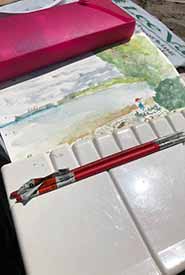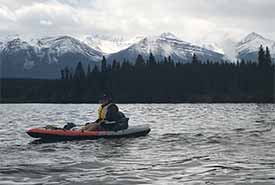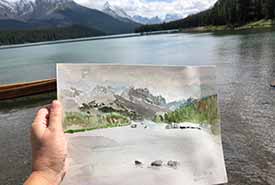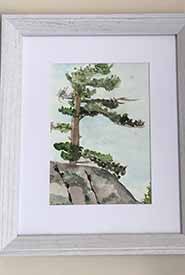The joys of capturing memories with watercolour painting

Nature was the balm we’d needed after months of physical distancing and pandemic-related uncertainties (Photo by Christine Beevis Trickett/NCC staff)
In the last few years, I’ve grown to love the joys of landscape watercolour painting as a way to capture time spent in nature, usually on annual canoe trips with my dad. Unfortunately, this year’s pandemic meant I couldn’t travel to Ontario for our trip. However, my husband and I did manage to squeeze in a trip to Jasper. And along with our suitcases, inflatable kayaks, life vests and paddles, I brought my travel painting kit.
Over the years, I’ve refined my kit so it’s something I can easily bring with me, even on remote canoe trips.
Related content:

My travel painting kit (Photo by Christine Beevis Trickett/NCC staff)
I usually pack a smaller block of paper rather than full sheets. Most of my paint tubes fit into a plastic pencil case, along with a pencil and small eraser. I use an old plastic gum container for water and bring only a fine and a medium brush rather than a full set of varying sizes. My paint palette is a compact one that I can hold with one hand, and I usually leave enough dried paint in it that I often don’t need to pull out my paint tubes. Add to that a rag for wiping my brushes or dabbing at the page, and I’ve got a paint kit that fits easily into most backpacks, whether hiking or paddling.
On one of the first mornings in Jasper, we drove to Pyramid Lake, near the town centre. Inflating our kayaks, we pushed off into the lake, surrounded by towering mountains and trees reflected in the near-glassy water. Rounding a bend in the shore, we could almost believe we were far away from everything. Breathing in the cool mountain air, a sense of calm enveloped me as I listened to the sound of the wind whispering through pine branches.
It was a paddle as magical as the misty mountains around us. Nature was the balm we’d needed after months of physical distancing and pandemic-related uncertainties, and we felt as light as the kayaks we floated on. But by the time we landed back on shore, my fingers and toes were too cold to contemplate painting the scene.
The next day, we drove out to Maligne Lake; a much larger body of water than Pyramid Lake, it also offered us breathtaking views fit for a postcard. We were excited to make more memories together.
But upon inflating the kayaks in the parking lot, my husband heard a hiss. Thinking it was just a loose nozzle cap, we tightened everything and brought our gear to the shore. While I headed back to the parking lot to return some gear we didn’t need, my husband took the hissing kayak into the lake for a test paddle.
Returning to the water just a few minutes later, I chuckled at the sight of him in the kayak, now bowed into the shape of a banana, as the air continued to leak out.
And then I remembered my paints in our backpack.

Setting myself up on the lakeside dock, I told him to take the other, non-leaky kayak. Much as I’d have loved to share the experience with him, I was also keen to get at least some painting time in. As my husband paddled into headwinds and up to the nearest point, I sat on the dock and got to know the view we were so lucky to experience.
While kayaking is one way to get to enjoy our surroundings, and literally immerse ourselves in them, painting on the shore gives you a completely different experience of a landscape. It’s a way to slow down and truly see and sense the nature around you from a different vantage.

Maligne Lake, AB. Painting allows you to slow down and see and sense the nature around you from a different vantage. (Photo by Christine Beevis Trickett/NCC staff)
As you paint, the reflections on the water change as clouds pass by, gradually changing the impression of the landscape, so you have to work relatively fast. Shadows on hills and mountainsides gradually darken and lighten or move across the land as the sky changes and the sun crosses the sky. The breeze and sun dry the paint or sometimes move it around on the page, depending on the effect you want to capture. By the time you rough in the clouds and move on to objects in the distance, working from far to near, light to dark, the sky may have completely changed. And while a travel painting will never be quite as polished as one done at home, it is a wonderful way to capture the impression of a place and create a memento to bring home with you.

A travel painting framed and hung it in our hallway (Photo by Christine Beevis Trickett/NCC staff)
Eventually, my husband returned to shore (having recaptured a paddle that blew away on his way back into shore, facing headwinds…but that’s a story for another time).
As the kayak deflated and our gear and my painting dried, we lay on the dock, listening to music and letting the waves rock us. Packing up our belongings after a while, I included my painting. And when we returned home, we framed and hung it in our hallway — a reminder of a day we won’t soon forget.


